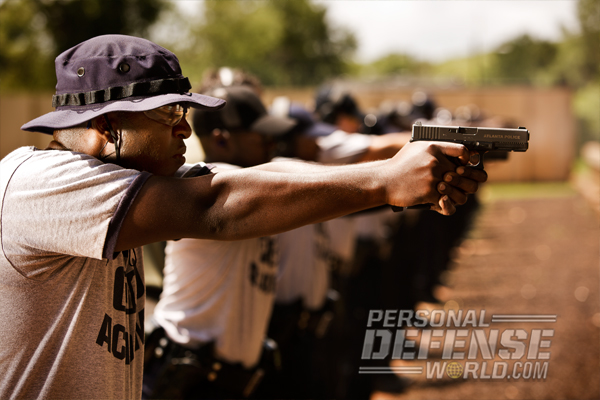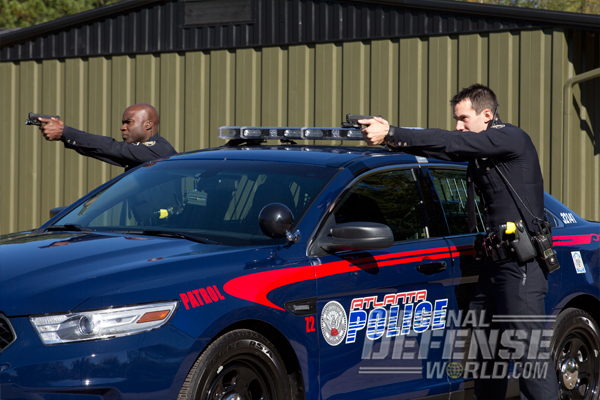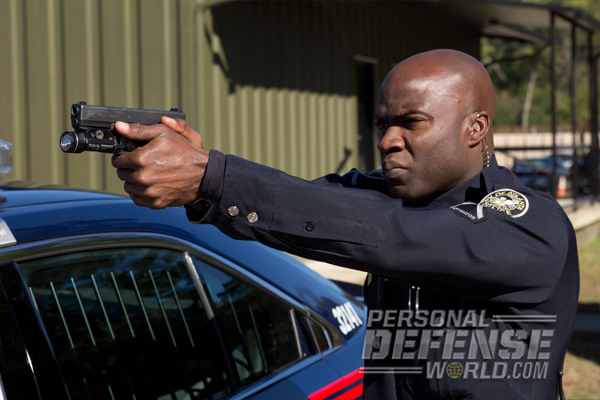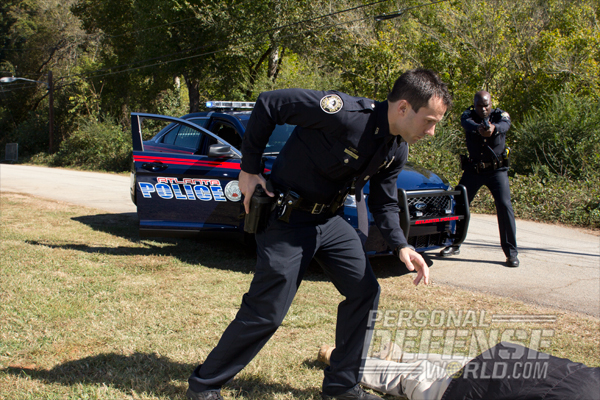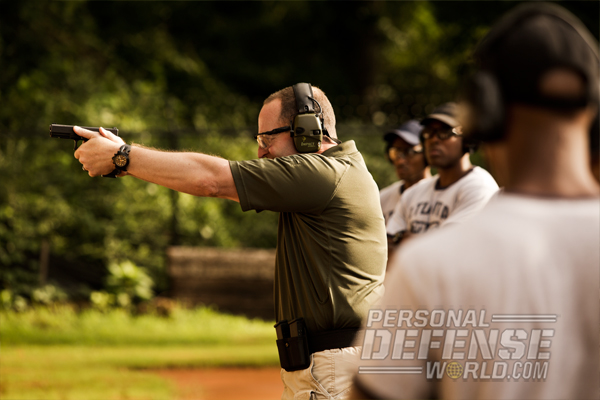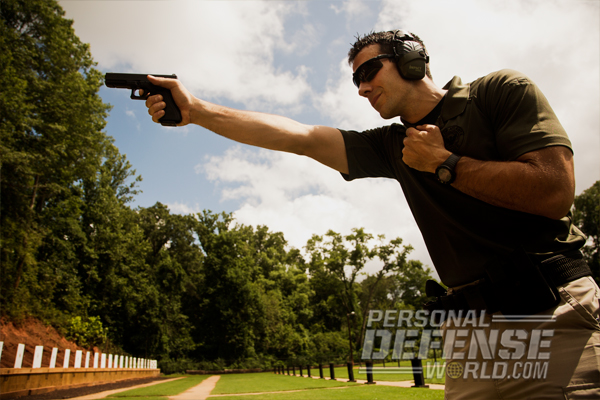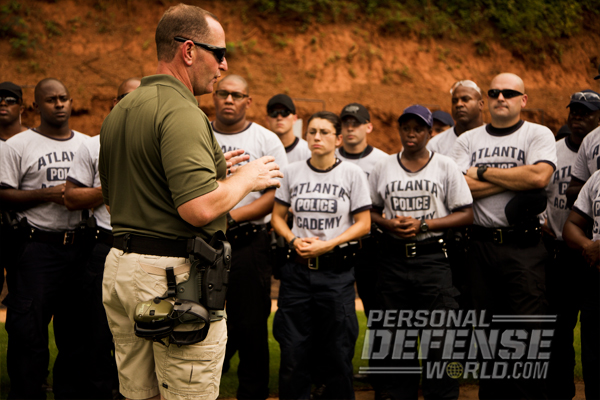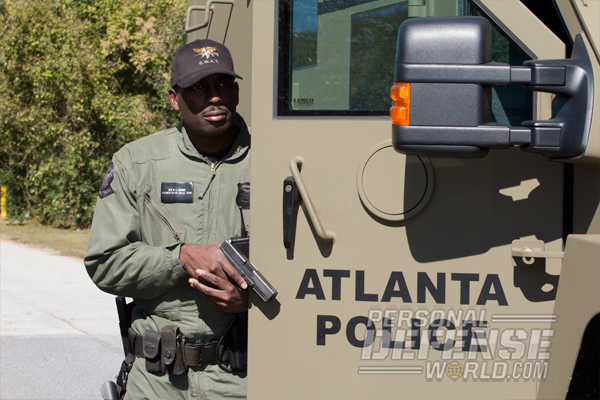Atlanta, Georgia, titan city of the South and alternatively known as “Hot-lanta” and “the ATL,” has been making history since the outbreak of the Civil War over 150 years ago. In 2013, Atlanta earned a place in the history books yet again when it became the first major metropolitan police department to procure GLOCK Gen4 pistols. Host to the 1996 Olympics, the planet’s busiest airport and major companies like Coca-Cola, the U.S.’ ninth-largest metropolitan area has for a number of years been a dynamic and progressive place. And, like all cities, Atlanta requires a professional, modern law enforcement agency.
ATLANTA PD:
When it was established in 1873, the Atlanta Police Department (APD) was composed of a chief of police and 26 officers. Today, the number of sworn personnel is approaching 2,000, and the APD is a complex, multi-faceted organization, as befits an internationally known metropolis. The APD has it all: uniform patrol, motorcycles, helicopters, SWAT, K-9 units and even horse-mounted units. Whatever his or her specific role, every sworn APD member depends on the department’s issued sidearm as the first line of defense. Long guns (rifles and shotguns) and other equipment are available, but the service handgun is carried always. Unlike a number of early police departments, whose personnel carried guns they personally owned, the APD at its founding purchased and issued standard weaponry. The department’s first handguns were .44-caliber Colt Lightning revolvers. These remained in service until the 1920s, when they were replaced by a series of .38 Special Colt revolvers. In the late 20th century, the department switched to semi-automatic pistols. In 2013, however, after extensive testing and evaluation, the APD picked the GLOCK 22 Gen4 in .40 caliber as its standard-issue sidearm. Other GLOCK models will sit in the APD’s holsters, too.
Advertisement — Continue Reading Below
“The idea is a good one, as the Glock 22R allows shooters to focus on the mechanics of shooting without experiencing the distraction of report noise and muzzle-blast pressure.”
INEFFICIENT .38s:
Your correspondent has lived in the Atlanta metropolitan area for over half a century. I have vivid memories of “big men in blue” with six-shot, double-action revolvers held in Jordan leather holsters with a retention strap—“state of the art” police equipment in the 1960s. Like most American agencies, the department’s standard ammunition was a .38 Special, 158-grain, round-nose, lead loading. As a boy, I had an early morning paper route on the north side of the city (Buckhead), and it was my usual practice to meet a couple of APD officers at a diner and supply them with an extra late edition. The officers kept an eye out for the newspaper kid, and I in turn reported anything suspicious. They had just settled in when one received a call over his portable radio to check on a prowler at a local apartment building. Complaining good-naturedly, he got up and stepped out into the predawn darkness to his marked patrol car. The other officer settled into the booth with a newspaper and coffee. Minutes later, a cry for help crackled from the walkie-talkie. It turns out the other officer had been fired on as he exited his car in the dim parking lot of the apartment complex!
I was once told by an APD uniformed officer, “If you can just hang on for a couple of minutes, the world is coming to help.” So it went: Not long after engaging the initial officer, the suspect was confronted by multiple responders; he continued to violently resist, and compliance was achieved by gunfire. The inefficient .38 Special ammunition necessitated multiple shots by the police, and even then the attacker survived! He was tried and imprisoned after recovering. Thereafter, I exercised a little more alertness and caution near that locale.
Advertisement — Continue Reading Below
Over the decades, in keeping with the technological advances driving the firearms industry, the APD adopted a DA/SA design, first in 9×19 and then in .40. State-of-the-art ammo was adopted, too. Transitioning from semi-wadcutter revolver ammunition to high-performance jacketed-hollow-point (JHP) semi-automatic cartridges, the APD did its best to supply its “thin blue line” with the tools it needed.
FAST FORWARD:
Sergeant W. Burras and Senior Police Officers M. Banja and P. Fite of the APD are quintessential professionals: They take their jobs as firearms instructors very seriously and yet aren’t in any way overbearing. Successful graduates of state and private academies, all three are dedicated to their profession and to providing the men and women of the APD with the best training and equipment possible. They are part of a four-person core unit of firearms instructors that is augmented by about 30 adjunct APD personnel. The unit puts annually around 2,000 sworn APD personnel through training and evaluation. Toward the end of 2012, Chief George N. Turner and the department’s senior command staff decided that the department’s sidearm standards needed changing. Firearm performance and maintenance issues dogged the department, and Banja and Fite, who had studied the problem, were conducting tests in pursuit of a better sidearm. Their test subject: the GLOCK 22 Gen4.
Advertisement — Continue Reading Below
The Glock 22 Gen4, the latest iteration of America’s most popular police handgun, is a double-action-only (DAO), locked-breech semi-automatic pistol. Chambered in .40 and featuring a standard magazine capacity of 15 rounds of ammunition (optional 22-round magazines are also available), the Gen4 series was developed as the successor to GLOCK’s third-generation handguns, which are standard-issue in numerous U.S. federal, state and local agencies. Featuring polymer-frame construction, the time-tested cold-hammer-forged barrel with polygonal rifling, a super-hard and corrosion-resistant finish on major metal components like the barrel and slide, GLOCK’s famous SAFE ACTION fire-control system with three automatic and independent safeties, and interchangeable backstraps, the Gen4 “enhanced perfection.”
The 360-degree, rougher texture on the GLOCK’s polymer frame helps users deal with the heat and humidity typical of Georgia’s summer weather—as well as with the occasional winter ice storm. The Gen4’s magazine catch is reversible and offers a larger contact surface for one’s finger. The engineering pièce de résistance is the Gen4’s dual recoil spring assembly, which offers unprecedented reliability and performance. GLOCK pistols may well be the most tested handguns of all time, both from a range and a real-world perspective. Officers Banja and Fite, however, had a test in mind that would uniquely demonstrate the GLOCK’s durability and reliability.
HOMETOWN HANDGUN:
GLOCK’s North American headquarters is located in Smyrna, Georgia, just outside of Atlanta. Since 1986, the Smyrna office has served as the nexus for sales and service in the U.S. and Canada. Last year, the APD called Smyrna. Jamey Brown, GLOCK’s district manager, responded immediately with a set of test pistols. Director Alan Ramsey of GLOCK Professional provided training support in the form of armorer and firearms instructor courses.
The APD began its evaluation of the Glock 22 Gen4 by taking one and having a class shoot through it without stopping 1,000 rounds of full-power .40-caliber ammunition. The gun got so hot that the front night sight element melted! The GLOCK, however, never missed a beat. The front sight, by the way, was replaced the next day, and testing continued.Experienced shooters know that the essential element in achieving an accurate shot is controlling the weapon’s trigger at the moment of discharge and immediately thereafter. Difficulties had arisen with the current service pistol’s trigger weight and “feel.” Banja and Fite hypothesized that the GLOCK service trigger (which has a 5.5-pound trigger pull weight) might very well improve performance. They tested their theory with recruits and serving officers.
Advertisement — Continue Reading Below
With no familiarization training at all, the recruit class performed better during its qualification course when using the GLOCK Gen4. Hoping to determine whether a GLOCK could help a poor shooter with his or her shooting, Banja and Fite devised a second test: Gathering nine shooters considered “challenged” in their shooting ability, the seasoned instructors provided the students with Gen4 GLOCKs and models of the current duty pistol and had them shoot the two in alternation. The result? “The GLOCK handgun performed significantly better in the hands of a poorer shooter” than the then-current duty sidearm. Finally, range staff deliberately elected to leave the sample GLOCKs uncleaned to test reliability. After firing over 6,000 duty rounds through the GLOCKs, no malfunctions were observed.
MAKING THE SWITCH:
The die was cast, and the decision was made: The Glock 22 Gen4 with a standard magazine capacity of 15 rounds was chosen as the standard-issue pistol of “Atlanta’s finest.” The APD ordered several other models and calibers, too: The GLOCK 21 Gen4 in .45 AUTO, with a 13-round standard magazine, (check out the new GLOCK .45: the GLOCK 41 Gen4) was designated for the experienced, top-tier SWAT team. The GLOCK 26 in 9×19 was chosen for special assignments. In this writer’s experience, the G26, which carries a standard 10-round magazine, functions perfectly well with the GLOCK 19’s 15-round, the GLOCK 17’s 17-round and even the GLOCK 18’s 33-round standard magazines, making it one heck of an off-duty or backup gun!
Advertisement — Continue Reading Below
All of the APD’s issued GLOCKs feature tritium, three-dot night sights calibrated for the model and ammunition. Powering the pistols are several Winchester loads: 180-grain Ranger SXT JHPs in .40, the 230-grain T-series in .45 AUTO and 147-grain SXT in 9×19. For holstering its GLOCKs, the APD has chosen Safariland’s ALS holsters. In an interesting instructional and training gambit, the APD has ordered a set of GLOCK 22R (for “reset drills”) Gen4s to help students learn trigger control and sight focus. The idea is a good one, as the Glock 22R allows shooters to focus on the mechanics of shooting without experiencing the distraction of report noise and muzzle-blast pressure. Bill Rogers of the Rogers Shooting School has done pioneering work on the benefits of reset training, and the APD’s results should affirm the wisdom of the strategy.
The first GLOCK pistols were delivered to the APD in July 2013. Immediately, department shooting skills improved. The growth was directly attributed to GLOCK’s SAFE ACTION fire control system. This writer had the opportunity to observe some of the department’s shooting drills, and I noted no problems or concerns. Of particular interest at the first session I witnessed was a 48-round evaluation drill that the APD’s instructors sometimes shoot during their lunch. The drill involved a single silhouette target at which the participants shot under fairly tight time limits from various distances up to 25 yards. A single miss resulted in a fail! Not surprisingly, the drill had never been “cleaned” with a perfect score. One APD instructor, shooting his newly issued Glock 22, posted the first maximum score! He commented that he was now solidly “pro-GLOCK.” Other APD officers have expressed their pleasure and, indeed, relief at the fact that they now have at their disposal powerful, reliable, dependable GLOCK autopistols.
With GLOCK’s North American headquarters located in nearby Smyrna, the APD is assured of nearly instant and completely competent customer service. Through GLOCK Professional, being held at the new GLOCK training facility, APD personnel are free to take part in armorer and shooting training. All in all, the Atlanta Police Department made a wise and powerful choice for officer safety and community protection: It opted for GLOCK’s unbeatable Gen4s!
Advertisement — Continue Reading Below
For more information on GLOCK firearms, visit: http://us.glock.com/
